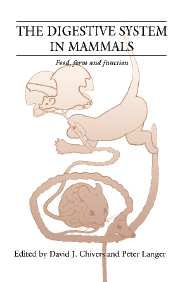Book contents
- Frontmatter
- Contents
- List of contributors
- Preface
- Part I Introduction
- Part II Food
- 5 Foods and the digestive system
- 6 Classification of foods for comparative analysis of the gastro-intestinal tract
- 7 The ‘carnivorous’ herbivores
- 8 Nutritional ecology of fruit-eating and flower-visiting birds and bats
- 9 Herbivory and niche partitioning
- 10 Taste discrimination and diet differentiation among New World primates
- 11 Potential hominid plant foods from woody species in semi-arid versus sub-humid sub-tropical Africa
- Part III Form
- Part IV Function
- Part V Synthesis and perspectives
- Index
8 - Nutritional ecology of fruit-eating and flower-visiting birds and bats
Published online by Cambridge University Press: 18 March 2010
- Frontmatter
- Contents
- List of contributors
- Preface
- Part I Introduction
- Part II Food
- 5 Foods and the digestive system
- 6 Classification of foods for comparative analysis of the gastro-intestinal tract
- 7 The ‘carnivorous’ herbivores
- 8 Nutritional ecology of fruit-eating and flower-visiting birds and bats
- 9 Herbivory and niche partitioning
- 10 Taste discrimination and diet differentiation among New World primates
- 11 Potential hominid plant foods from woody species in semi-arid versus sub-humid sub-tropical Africa
- Part III Form
- Part IV Function
- Part V Synthesis and perspectives
- Index
Summary
Volant vertebrates include two extant groups: birds and bats. Both of these taxa are commonly used as model organisms for studies of community and population ecology (Kunz, 1982; Wiens, 1983) and foraging behaviour (Morrison et aL, 1988). Despite this, the nutrition and digestive function of birds and bats are too often considered inscrutable black boxes, or worse, ignored by ecologists and behaviourists (Wheelwright, 1991). There are several reasons why the processes by which these animals digest and absorb nutrients should be of interest to animal ecologists and behaviourists. The design and adaptability of the gut may determine diet diversity and hence niche width (Martinez del Rio et al, 1988). Digestive processes may set limits on metabolizable energy and nutrient intake and thus determine rates of growth and reproduction (Kenward and Sibly, 1977; Karasov et al, 1986). In addition, nutrient assimilation is one of the factors that mediates the interaction of animals with their environment (Martinez del Rio and Restrepo, 1992).
Out of neglect, the contributions of nutrition and digestive physiology to ecology and behaviour have been minor. We know little about how digestion influences feeding choices (Martinez del Rio and Karasov, 1990), constrains meal sizes and frequencies (Carpenter et al, 1991), determines rates of growth and fat accumulation (Konarzewski et al, 1989), or affects interspecies interactions. With the notable exception of several studies on pollinator energetics (summarized in Heinrich, 1975), comparative avian/chiropteran physiologists have also overlooked the potential of their field as a tool to understand interactions among species.
- Type
- Chapter
- Information
- The Digestive System in MammalsFood Form and Function, pp. 103 - 127Publisher: Cambridge University PressPrint publication year: 1994
- 18
- Cited by



